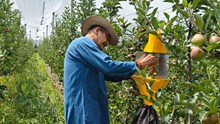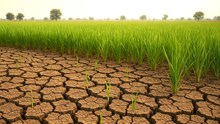
Jharkhand, located in the Chota Nagpur Plateau, features a breathtaking landscape of lush forests and rolling hills, home to a rich variety of wild mushrooms. Among them, Rugda (Astraeus hygrometricus), known as the “Barometer Earthstar,” stands out. Revered for its chicken-like taste, this mushroom—often called the “meat of the vegetarian”—is more than a culinary delight. For tribal communities, Rugda is a seasonal treasure that not only enhances their monsoon diet but also supports their livelihoods.
These mushrooms thrive in untouched sal and teak forests, especially after a good rainstorm. The tribal women, who have a deep understanding of the forest ecosystem, skillfully locate the best spots by following a delicate, white fungal network that weaves through the ground. Once the rains come, they carefully dig a few inches beneath the sal trees’ canopy to gather the mushrooms. These mushrooms typically grow in clusters of 4 to 10, hidden beneath the forest floor.
Where and When It Grows
The districts of Ranchi (particularly Bundu, Tamar, and Pithoria), Chaibasa (Bandgaon), and Lohardaga are home to the majority of Rugdas. These mushrooms thrive in lateritic, slightly acidic soils (pH 5.5–6) with temperatures around 30°C and more than 350 mm of precipitation. According to local belief, lightning and thunder contribute to the release of nitrogen dioxide into the soil, which enhances the growth of mushrooms. Early July through September, right before the monsoon season ends, is harvest season.
A Short-Lived Delicacy
Even when kept in soil, rugda mushrooms are extremely perishable and only last three to four days. For this reason, they are frequently bought and eaten on the same day. Depending on quality, availability, and freshness, they can sell for anywhere from Rs. 100 to Rs. 300 per kilogram in local markets. Rugda mushrooms are mostly sold and consumed in the local villages and weekly haats because they are difficult to transport and preserve.
Why Rugda is Special
Unlike to cultivated mushrooms such as button or oyster, Rugda cannot be artificially grown. It develops underground, has no stem, and is like a puffball. When cut open, it exposes white or white-black inner flesh, the edible portion. If the flesh has become fully black, it becomes overripe and unfit for consumption. Its pungent earthy smell and distinctive taste make it a highly prized ingredient for tribal curries, described as being like meat in both flavor and texture.
Rugda belongs to a family of fungi known as ectomycorrhizal fungi. The mushrooms develop a symbiotic relationship with the roots of trees, particularly sal, jamun, amla, and eucalyptus. They obtain nutrients from the soil and provide the trees with essential minerals such as phosphorus in exchange. This makes Rugda not only a mushroom but a vital component of the forest ecosystem.
Nutrition Packed in Every Bite
Rugda's remarkable nutritional profile is what makes it really valuable. Protein (14–16%), fiber, vitamins (ascorbic acid and thiamine), essential amino acids, and minerals (calcium, iron, phosphorus, and potassium) are all abundant in it. It is perfect for a balanced diet because it is high in energy and low in fat. Additionally, traditional communities use Rugda medicinally, particularly the spores, which are combined with mustard oil to treat burns. Its medicinal value is increased by recent research that supports its anti-inflammatory, antioxidant, and anti-cancer qualities.
Conservation and Use Challenges
Rugda is still mostly unknown outside of Jharkhand, despite being a staple in tribal diets. The main obstacles are its short shelf life, lack of storage techniques, and lack of commercial cultivation. Its natural habitat is also being impacted by human encroachment, deforestation, and climate change. Tribal communities may lose this forest treasure if it is not protected, depriving them of a seasonal source of income and food.
Road Ahead
For Rugda to become a valuable source of income for our rural people, we require concerted efforts in research, awareness, and conservation of forests. State agricultural universities and state forest departments must collaborate to learn about the life cycle of the mushroom and identify means to conserve it without compromising on the ecosystem. Basic methods such as drying, powdering, or canning would lengthen its shelf life and provide new market opportunities.
The tribal women collectors should also be supported by the state government through training, equipment, and facilitation of better markets. If planned well, Rugda can be a certified non-timber forest product that enhances rural livelihoods, nutrition, and the indigenous food culture of Jharkhand.
Rugda mushroom is more than a seasonal delicacy—it’s a powerful symbol of Jharkhand’s rich biodiversity, tribal heritage, and the untapped wealth hidden within our forests. With growing demand for natural, nutritious foods and a market price of Rs. 100 to Rs. 300 per kg, Rugda holds immense potential to uplift rural livelihoods. By investing in its conservation, sustainable harvesting, and better market access, we can empower forest communities and pave the way for a healthier, more sustainable future.
















